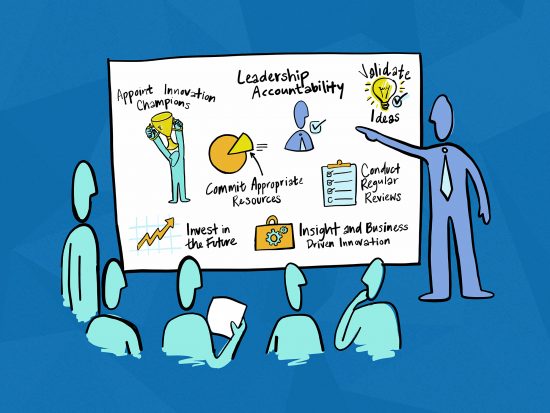In the first blog of this series on leading for innovation, I shared the importance of encouraging an innovative culture and the pivotal role that the leader must play in the process.
In the next two installments, we’ll look at some of the specific behaviours that leaders must employ to create an innovation-focused mindset amongst employees and ensure buy-in from every level of the organisation.
First and foremost, demonstrating effective support for innovation is key as people will follow your lead. This can take many forms, but some of the most effective include clear and regular communications about the organisation’s innovation goals, why it’s needed, the provision of innovation training to all levels of employees, and acting as a mentor to specific innovation teams.
Leaders “walking the walk” make a huge impact and quickly permeates the organisation as everyone can see how seriously the leadership team is about innovation. Conversely, adopting a “do what I say, not what I do” attitude only serves to create a mismatch in message that confuses and stifles enthusiasm amongst employees.
Committing appropriate resources is another important step to enabling long-term culture shift. This may be ring-fencing budgets, or allocating time in employees’ workloads specifically for innovation projects. After all, it’s unrealistic and unfair to expect your people to produce innovation if they’re maxed-out with “run-the-business” work. Appointing innovation champions can also be useful. Doing so means all innovation activity is channeled through a specific group, providing a companywide overview and ensuring multiple teams aren’t working on similar ideas.
Linked to this, ensure there’re accountability in the leadership team for innovation performance, keeping it front and centre to clearly demonstrates how much it matters. Often innovation isn’t reported on at the top table, leading to a perception that it’s not as important as ongoing operational activity. However, a short-term mindset will only damage the business in the long run.

Effective innovation means looking beyond the here and now, investing in the future to ensure the business will actually have a future. Associated risks are minimised by spreading available resources across a diverse range of innovation ideas and concepts, while conducting regular reviews with the teams involved keeps ongoing projects on track.
Finally, ensure that all innovation strategy and activity comes from insight and is business driven. Speaking to customers to understand their problems and their “jobs to be done” is key for a leader, and will lead to copy-cat behavior. This will prevent well meaning, but blinkered teams from persisting with their solutions to issues that don’t actually exist or don’t actually meet the customer need.
As per Ash Maurya, ‘life is too short to build something nobody wants.” Make sure innovation teams aren’t working in isolation, have access to all the necessary data and insights they need, and validate their ideas with customers to minimise this issue and keep them on the right track.
In the next blog, we’ll look at four more essential behaviours of a leader to encourage and foster an innovative culture, regardless of an organisation’s size or industry standing.
Remember that disruption can come from anywhere and there’s no such thing as ‘too big to fail’ anymore. Encouraging innovative thinking is the best defense against a slow death by complacency. Don’t let it happen to your business.
CONNECT WITH US